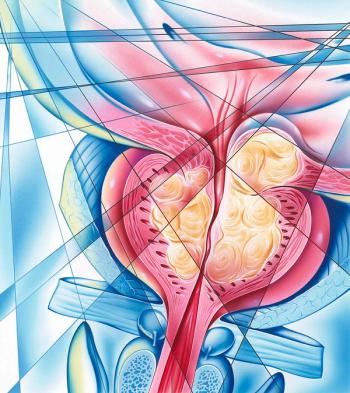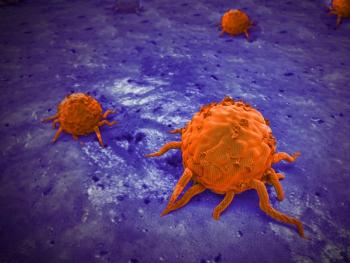
Deadly Aggressive Form of Prostate Cancer Is Surprisingly Common
Small-cell neuroendocrine disease associated with prostate cancer treatment appears to be more common than previously believed.
Cancer Network spoke with Rahul Aggarwal, MD, an assistant professor of medicine in the Division of Hematology and Oncology at the University of California San Francisco. Dr. Aggarwal specializes in developing novel therapeutic and imaging strategies for patients with advanced prostate cancer. He and his colleagues recently published a study indicating that small-cell neuroendocrine prostate cancer-a deadly form of advanced prostate cancer-is more common than previously believed. The study is
-Interviewed by Anna Azvolinsky
Cancer Network: First, prior to your study, what was known about the epidemiology of prostate cancer as it relates to your research? How often are early-stage and advanced-stage prostate cancer diagnosed, and also the small-cell neuroendocrine prostate cancers that you examined in your work?
Dr. Aggarwal: Thank you for the question and for the opportunity to discuss our study. We generally think that the previously described form of small-cell neuroendocrine cancer, the type that is there at the time of diagnosis (what would we term de novo neuroendocrine prostate cancer), is quite a rare entity. There have been multiple prior publications reporting an incidence of less than 1%, so quite a small number of prostate cancer patients.
We found in our study that when we examine patients already diagnosed with prostate adenocarcinoma (the most common prostate cancer) who are subsequently treated with a series of hormonal therapies (a standard treatment for prostate cancer), [in half of cases] the cancer becomes resistant to those hormonal therapies and spreads to other parts of the body-most commonly the bone or lymph nodes. When we biopsy tumors that reside in those new locations, we see a much higher incidence of small-cell neuroendocrine prostate cancer. So, in our publication in JCO, we report an incidence of 17%. When you compare that to the less than 1% of cases that you see at the time of diagnosis, clearly the treatment-associated or treatment-emergent small-cell neuroendocrine prostate cancer is much more common than previously thought.
Cancer Network: What made you and your colleagues initially examine the frequency of this thought-to-be-rare, small-cell neuroendocrine prostate cancer among those diagnosed with and treated for prostate cancer?
Dr. Aggarwal: It’s interesting, because this original effort was not necessarily geared at studying just small-cell neuroendocrine prostate cancer. It was really to biopsy any patient with an accessible metastatic tumor that was hormone-resistant and to understand the mechanisms of resistance: How does prostate cancer become resistant to hormonal therapy, and what are the next therapeutic targets we can go after with that information? So this was a large multi-institutional project funded by Movember, Stand Up 2 Cancer, and the Prostate Cancer Foundation.
It just so happened that, as we were doing these biopsies and having a central pathology review of them, we were noticing that we were seeing a lot more cases of small-cell neuroendocrine prostate cancers than we would have expected to see. So I think as the project grew, this became one of the central focuses of the project, to characterize the incidence of this tumor type and of course to describe the genetic and gene expression profiles of these tumors.
One of the advantages of our study is that we didn’t have any pre-selection criteria; these were not patients who were previously diagnosed with small-cell neuroendocrine prostate cancers. We really enrolled a consecutive series of patients across institutions, and the criteria were fairly broad: you had to have metastatic prostate cancer that had become hormone-resistant to standard testosterone-lowering therapy. And then we enrolled patients and did a central pathology review to really get a careful understanding of whether, in fact, the tumor looked like it had small-cell neuroendocrine features. So in some sense, there was an unbiased or less-biased approach, but we probably did still select for patients who had tumors that were accessible for biopsies. That might have enriched for a higher-risk group of patients; nevertheless, it does give a fairly true sense of the incidence of this tumor type in the hormone-resistant setting.
Cancer Network: You mentioned that this was a multicenter study and described the types of patients enrolled. Is there anything else about the design of your study that is important to mention?
Dr. Aggarwal: The study design was to take men who had been on hormonal therapy when the cancer progressed. We did standard imaging tests, which typically include a picture of the bone, as well as a CT scan to determine where all of the prostate cancer had spread. Then we would have an interventional radiologist perform metastatic tumor biopsies and review all of the scans to determine whether there was a spot that was accessible for biopsy. That, in and of itself, required a fair amount of expertise, especially with spots of cancer in the bone.
Historically, it’s been really hard to get access to these tumors in the bone because it’s just a challenging spot to biopsy. But with proper training and expertise, we were successful the majority of the time in getting tumor samples out of these metastatic bone biopsies. And that really allows us to understand the biology of the cancer at this stage. So operationally, patients were biopsied at the time that their cancer became hormone-resistant. They were subsequently followed, and that was important.
We did have every-3-month follow-up, including for long-term outcomes of survival. That is what allowed us to capture some of these outcomes in the article that we published. We captured what subsequent therapy patients received. There was the option at the time for future dates of patients to undergo a second biopsy at the time their cancer became resistant to whatever therapy was applied. That was not the focus of the publication in JCO but is an ongoing source of investigation, to really analyze patients who have these valuable pairs of biopsies at two different points in time.
Cancer Network: What are some of the important details of what you and your colleagues found when you analyzed the results?
Dr. Aggarwal: I think there are a few take-home messages. One is what we just talked about, that the incidence of small-cell neuroendocrine prostate cancers is much higher than we thought. That, in and of itself, is an important finding. Secondly, there weren’t any particular clinical features that were standouts in terms of finding these small-cell neuroendocrine prostate cancers-and to me that means we should be thinking broadly about tumor biopsies whenever a tumor is accessible, to really look for this type of tumor in the metastatic hormone-resistant setting. Previously our treatment guidelines would call for looking for this type of cancer when there were special features like cancer spots in the liver and other things that occur less commonly with prostate cancer. Our results would suggest that we should look more broadly for this type of cancer.
I think the other take-home message is that the other big theme emerging in prostate cancer is that there is a subset of probably 20% to 30% of patients with hormone-resistant advanced disease who have mutations in genes involved in DNA repair. These are genes like BRCA that we classically think of as playing a role in some breast and ovarian cancers but that are actually mutated in prostate cancer as well. One of our key findings was that finding the small-cell neuroendocrine prostate cancer was nearly mutually exclusive with finding these DNA repair mutations. So this suggests that if you think of prostate cancer as a whole pie, these might be two separate slices of the pie: distinct subsets of prostate cancer.
When we think about personalizing prostate cancer treatment, the more we can divide up the pie into distinct subsets and treat patients based on what slice of the pie they fall into, I think we are likely to see improved outcomes for patients in this setting. And then the final take-home point is on some of the work we did on the gene expression profile: what genes are turned on or off. Some of the more sophisticated gene pathway analyses pointed the way to potential treatment targets for this group of patients. There is ongoing work as a follow-up to the study, to develop clinical trials and new medicines particularly based on the data from this study. [The goal is] to improve outcomes and to conduct clinical trials specifically for this group of patients, to see if we can make an impact.
Cancer Network: Anything else on the implications of this work? What else are you and your colleagues doing now to follow up on these results?
Dr. Aggarwal: I think the clinical trial piece is important here. And also the broadening of these results and the implications beyond just for academic institutions that have expertise in doing these types of biopsies-to really find noninvasive markers of this disease. Are there imaging tests or blood tests that could pick up this type of prostate cancer? That would [make a huge impact], as it would make this diagnosis a lot easier rather than having to do tumor biopsies on every patient, because there are certainly many patients who don’t have a lesion that we could biopsy.
So we are probably missing patients to study when we rely solely on biopsy. There is a lot of work ongoing to really understand that piece of this, to expand detection to a broader patient population. That would be enormously beneficial for detecting this, as well as thinking about how we could efficiently accrue patients for clinical trials. The more easily we can find these tumors, the less invasively we can find them, the better these types of studies will [be at patient accrual] and ultimately at impacting outcomes for this group of patients.
Newsletter
Stay up to date on recent advances in the multidisciplinary approach to cancer.



















































































